A New Method for Symmetric NAT Traversal
in UDP and TCP
Yuan Wei
Waseda University
3-4-1 Okubo, Shinjuku-ku,
Tokyo, JAPAN
Daisuke Yamada
Waseda University
3-4-1 Okubo, Shinjuku-ku,
Tokyo, JAPAN
Suguru Yoshida
Waseda University
Tokyo, JAPAN
Shigeki Goto
Waseda University
Tokyo, JAPAN
3-4-1 Okubo, Shinjuku-ku,
3-4-1 Okubo, Shinjuku-ku,
{wei,daiski,yoshida,goto}@goto.info.waseda.ac.jp
ABSTRACT
This paper proposes a new method for Network Address
Translator (NAT) Traversal in UDP. Several techniques have
been proposed for traversing NAT or firewall boxes in UDP.
These techniques can establish UDP communication between
hosts behind NATs. However, existing NAT traversal meth-
ods, including Universal Plug and Play (UPnP), Simple traver-
sal of UDP over NATs (STUN) and Teredo, cannot traverse
symmetric NAT boxes. Our method uses a new port predic-
tion method. It controls ports to traverse symmetric NAT
boxes as well as other kinds of NATs. In addition, our new
method can be extended for simple NAT traversal in TCP.
The method is based on a new UDP hole punching tech-
nique.
We have tested nine working NAT products in our labora-
tory. The results show that our method can be practically
implemented for successful NAT traversal for real use.
Keywords
NAT traversal, Symmetric NAT, UDP, P2P, Stateful Packet
Inspection, TCP
INTRODUCTION
1.
A network address translator (NAT) is a well-known, ver-
satile tool that enables the reuse of IP addresses in the In-
ternet. Using a NAT, we can convert private IP addresses
to global IP addresses. However, a fatal problem can occur
if an applications protocol includes an IP address as part of
the payload of IP packets. This is because NAT translates
IP addresses in the header properly, it cannot convert IP ad-
dresses in the payload. Examples of applications that suffer
from this problem include Voice Over IP and Multimedia
Over IP applications such as SIP [1] and H.323 [2] as well
as online games.
Copyright is held by the author/owner(s).
Asia Pacific Advanced Network 2008,
4-8 August 2008, New Zealand.
Network Research Workshop 2008,
4 August 2008, New Zealand.
There have been many proposals to solve this problem. Sev-
eral real-time multimedia applications, online games, and
other applications that work properly across NATs have
been developed using standard techniques such as Universal
Plug and Play (UPnP) which has been adopted by many
vendors [3]. Another example of a commonly used protocol
is Simple Traversal of UDP (STUN) [4], which is an imple-
mentation of the UNilateral Self-Address Fixing (UNSAF)
protocol [5]. Teredo realizes an UNSAF mechanism by tun-
neling IPv6 over UDP/IPv4 [6]. However, these proposals
do not solve the problem completely because none of them
can work successfully with all types of NATs.
This paper proposes a new method for NAT traversal, which
is applicable to symmetric NATs as well as other types of
NATs. Symmetric NATs are used when high security com-
munication is required. For example, the most expensive
router sold by a Japanese manufacturer, who sells nine types
of routers in the market, is the one equipped with symmet-
ric NAT functionality. Symmetric NATs are installed as
routers in business enterprises and also as high-end routers
for home use. Our new method is based on port prediction.
It manipulates port numbers in order to traverse symmetric
NATs successfully. We have conducted several experiments
to evaluate the performance of our new method. The re-
sults show that our method can be practically implemented
for successful NAT traversal. In addition, the new method
can be also extended to develop a new method for NAT
traversal in TCP.
Section 2 describes the various types of NATs. Section 3
surveys the existing methods of NAT traversal. Our new
method is proposed in Section 4. Section 5 shows the results
of our experiments and Section 6 concludes this paper.
2. TAXONOMY OF NATS
The study on the STUN protocol [4], use terms such as Full
Cone, Restricted Cone, Port Restricted Cone and Symmet-
ric to describe the different types of NATs. These NATs
are discussed with reference to UDP only. We will mention
TCP NATs briefly in Section 4.4.
2.1 Full Cone NAT
A full cone NAT is also known as a one-to-one NAT. Once an
internal IP address and port are mapped to some external
�
Figure 1: Full cone NAT
Figure 3: Port restricted cone NAT
IP address and port respectively, all the packets with the
internal IP address and port will be translated to the fixed
external IP address and port. Furthermore, any external
host can send a packet to the internal host by sending a
packet to the mapped external address. The full cone NAT
is illustrated in Figure 1.
2.2 Restricted Cone NAT
In the restricted cone NAT, all requests from an internal IP
address and port are mapped to a fixed external IP address
and port. It is similar to the full cone NAT except that un-
like the full cone NAT, an external host s2 (with IP address
x) can send a packet to an internal host only if the inter-
nal host has previously sent a packet to the IP address x
through the restricted cone NAT. The restricted cone NAT
is illustrated in Figure 2.
Figure 2: Restricted cone NAT
2.3 Port Restricted Cone NAT
The port restricted cone NAT is similar to the restricted
cone NAT. However, the port restricted cone NAT also takes
the port numbers into account along with the IP addresses.
An external host can send a packet with source IP address
x and source port p to an internal host only if the internal
host has previously sent a packet to the IP address x and
port p. The port restricted cone NAT is illustrated in Figure
3.
host can send a UDP packet back to the internal host. The
symmetric NAT is illustrated in Figure 4.
Figure 4: Symmetric NAT
3. EXISTING TRAVERSAL METHODS
There have been many proposals on methods to traverse
NATs. This section describes some well-known techniques
such as UPnP, STUN, and Teredo. It should be noted here
that none of these techniques can be successfully imple-
mented for symmetric NATs.
3.1 UPnP
UPnP is a set of computer network protocols promulgated by
the UPnP Forum [3]. The UPnP architecture allows the de-
velopment of peer-to-peer networks of PCs, networked appli-
ances, and various wireless devices. When a new host needs
a connection, a UPnP device can automatically configure
a network address, announce its presence on the network
subnet, and exchange a description of device and services.
Currently, many Internet gateway vendors such as D-Link,
Intel, Buffalo Technology, and Arescom are offering devices
with UPnP functionality. NAT traversal in UPnP is known
as the Internet Gateway Device (IGD) Protocol. However,
one of the disadvantages of UPnP is that it requires that all
the devices in the network should support UPnP. Even if a
single device does not conform to the UPnP standard, we
cannot realize a peer-to-peer network.
2.4 Symmetric NAT
In a symmetric NAT, any request from an internal IP ad-
dress and a port number to some destination IP address and
port number is mapped to a unique external IP address and
a unique port number. If the same host sends a packet from
the same source address and the same port number but to
a different destination, a different mapping is used. Only
the external host that receives a packet from an internal
3.2 STUN
STUN is a protocol used for communication between a client
and a server [4].
If a peer-to-peer software package includes a STUN client, it
sends a request to a STUN server. The server then reports
back to the STUN client about the global IP address of the
NAT router. It also reports the opened port number at the
NAT for incoming traffic to the private network.
�
The STUN client determines the type of NAT in use on
the basis of the response of the STUN server. There are
certain differences in the handling of the incoming of the
UDP packets by various types of NATs. STUN works well
with three types of NATs:
full cone, restricted cone, and
port restricted cone NATs. One of the drawbacks of STUN
is that it does not work with symmetric NATs which are
often used in networks in large enterprises.
In general, STUN assumes that the NAT being used is a
cone type NAT. If we use a cone NAT, the IP address and
the port number of the STUN client are fixed. STUN cannot
handle symmetric NATs because the global IP address and
port number translated from the private address and port
number of the client are not fixed.
Figure 5: Using STUN to traverse NAT
3.3 Teredo
It is based
Teredo has been proposed by Microsoft [6].
on IPv6 tunneling technology. A Teredo client obtains a
Teredo IPv6 address from the Teredo server.
It utilizes a
IPv6 address with IPv6 tunneling in UDP/IPv4. A Teredo
client communicates with other Teredo clients and other
IPv6 nodes through a Teredo relay. A Teredo server should
have both an IPv4 global address and an IPv6 global ad-
dress. A Teredo relay should have an IPv4 global address
and an IPv6 global address. Teredo relay provides routing
between the Teredo clients and nodes on the IPv6 Internet.
Teredo does not work well with symmetric NATs.
4. NEW METHOD
In this section we propose a new method for UDP multi-
hole punching. This method establishes a UDP connection
between two end points through NATs, as shown in Figure
6.
The new method is based on port prediction and limited
TTL values. The method controls the port numbers to allow
successful traversing of symmetric NATs. It also works well
for the other types of NATs. In addition, the new method
can be extended to NAT traversal in TCP. It is well known
that NAT traversal in TCP is more difficult than that in
UDP. This is an advantage of the proposed new method.
4.1 Phase I
The new method is divided into three phases. In this method,
the client is known as an echo client and the server is known
Figure 6: New method of UDP multi-hole punching
as an echo server because there are a series of packet ex-
changes between them. An echo client communicates with
two servers S1 and S2. S1 and S2 record the IP address and
port number of the echo client, and these are then translated
by NAT a. The following are the steps of the method:
F1: The echo client communicates with S1. Then, S1 ana-
lyzes the port number mapped by NAT a.
F2: S1 conveys the port number to the echo client.
F3: The echo client sends a packet to S2. It includes infor-
mation obtained on the port number of NAT a when
the echo client communicated with S1. Then, S2 ana-
lyzes the port number of NAT a and records it. Fur-
thermore, S2 also records the information obtained on
the port number of NAT a when the echo client com-
municated with S1 at step F1.
4.2 Phase II
In phase II, the echo server communicates with S1 and S2
in a manner similar to that in phase I.
F4: The echo server communicates with S1. Then, S1 an-
alyzes the port number mapped by NAT b.
F5: S1 conveys the port number to the echo server.
F6: The echo server sends a packet to S2. The packet in-
cludes the port number information of NAT b obtained
from the communication of the echo server with S1 at
step F4. Then, S2 analyzes the port number of NAT
b and records it. Furthermore, S2 records the port
number information of NAT b obtained when the echo
server communicated with S1 at step F4.
�
the predicted port number and the punching mode to
the echo server.
F8: Based on this information, the echo server sends a large
number of packets. These packets have a fixed destina-
tion port and a low TTL value. The echo server binds
the port. The packets are then sent to the echo client.
F9: Using the two kinds of information obtained in phases
I and II, namely, the communications of NAT b with S1
and S2, we can predict a suitable port number for the
hole punching. S2 sends the information that contains
the predicted port number and the punching mode to
the echo client in a manner similar to that of step F7.
F10: On the basis of the information obtained in step F9,
the echo client sends many packets to the echo server.
These packets have a fixed destination port. The echo
client binds the port. After sending all the packets,
the echo client switches to the receiving mode.
In step F10, NAT b receives many UDP packets from the
echo client. If one of the source port numbers of the echo
client matches the destination port number mapped by NAT
b, then NAT b translates the packets and sends it to the echo
server successfully. The echo server closes all the opened
ports except the ports that have successfully received the
packets.
F11: The echo server replies to the echo client. It establishes
a P2P connection between the echo client and the echo
server at this stage.
Figure 7: Phase I
Figure 8: Phase II
4.3 Phase III
In phase III, the method performs port prediction. As de-
scribed in phase I, NAT a maps the port number twice,
one each in steps F1 and F3. For example, if NAT a uses
5361 in F1 and 5362 in F3, then we can predict that the
punching mode of NAT a is incremental and that the pre-
dicted port number is 5363. Thus the new method can de-
termine the punching mode as incremental , decremental , or
the skip mode. Then, it communicates the target global IP
address and the punching mode to the echo client and the
echo server. The echo client and the echo server receive the
information and then initiate multi-hole punching to estab-
lish communication between them.
F7: Based on the two types of information communicated
in phases I and II, namely the communications of NAT
a with S1 and S2, we can predict a suitable port num-
ber for hole punching. We can also determine the
punching mode. S2 sends the information containing
Figure 9: Phase III
4.4 Advantages of the New Method
Normal UDP communications
The new method puts small TTL value, 2 or 3, in a packet
from the Echo Server. In step F8 we observe that the packet
reaches NAT b but does not reach NAT a. In steps F8 to
F11, we can observe that packets go through NAT a or b,
as shown in Figure 6 and Figure 9. These packets appears
normal UDP communications if we neglect the extra packets.
�
Thus, UDP packets have less possibility of being discarded
because of the use of security criteria for screening packets
at NATs.
Precise port number prediction
Most NATs translate port numbers according to one of the
following algorithms: increment, decrement, leap, i.e., skip-
ping alternative port numbers, or random. Our proposed
method uses two servers so that we can observe any type of
port translation.
Control of port numbers
The new method uses fixed port numbers rather than ran-
dom numbers. When the source port numbers are {x, x +
1, x + 2, . . .} and the translated port numbers are {n, n +
1, n + 2, . . .}, we can detect the translation algorithm at
a NAT based on the sequences of the source ports and the
translated ports. The new method can also detect random
port translation.
Use of many port numbers
The new method uses many port numbers. The current
implementation uses 1,000 port numbers. The large number
of ports increases the success rate of hole punching. When
NAT a translates port numbers by some unknown algorithm
and one of the 1,000 ports matches with the mapping of NAT
b, the communication is successfully established.
Stateful Packet Inspection (SPI) in TCP
Currently, many NAT products are equipped with Stateful
Packet Inspection (SPI). It is a type of function for filtering
of TCP packets. When SPI is applied, a valid sequence of
packets should follow the 3-way handshake of TCP. The 3-
way handshake is as follows:
1. [SYN] - outgoing
2. [SYN, ACK] - incoming
3. [ACK] - outgoing
The proposed method can be extended to cover TCP NAT
traversal. It simulates the 3-way handshake in accordance
with SPI criteria. The actual packets are composed by the
echo server, the echo client, S1, and S2. A TCP packet has
two flags, SYN and ACK, which are easily set. The sequence
number is an important field in a TCP packet, which is com-
posed by S1 and S2 for NAT traversal. S1 and S2 monitor
the packets from the echo client and echo server to obtain
the original sequence numbers. Thus, hole punching can also
be extended to TCP using the new traversal method.
5. EXPERIMENTS
We conducted five experiments to evaluate our new method
and compared it with other existing methods. We used the
WinStun software to classify the type of NATs in the first
experiment. In the second experiment we used Wireshark,
which is a packet capture tool. In the third experiment, we
evaluated the use of the Skype software for NAT traversal.
The fourth experiment was performed to test the perfor-
mance of the new method for UDP NAT traversal. The
new method was applied to TCP NAT traversal in the fifth
experiment.
We tested several router products, which are shown in Table
1. The first router “Iptables” is not a hardware product but
a software tool for routing. It is included in the list so that
we can observe the details of Iptables.
It is also possible
to capture packets at a PC that runs Iptables. The other
routers listed are commercial hardware products, and we
do not know their detailed internal structure or functions.
This is the reason we conducted the first experiment on the
classification type of NATs.
Table 1: Routers used in the experiments
manufacturer model number
Iptables
I-O Date
I-O Date
Buffalo
Linksys
Planex
Corega
NEC
Cisco
Iptables
NP-BBRL
WN-WAPG/R
BBR-4HG
BEFSR41C-JP3
BRL-04CW
CG-BARMX2
AtermBR1500H
Cisco2621
5.1 Classification of Types of NAT using Win-
Stun
We used the WinStun software to classify NATs. WinStun
shows two outputs which are the possibility of NAT traversal
by STUN and the NAT type. The types of NATs are defined
in [7].
Figure 10: Network configuration of WinStun
The network configuration of the first experiment is shown in
Figure 10. The results of the first experiment indicate that
Cisco 2621 and IO-Data (WN-WAPG/R) are “impossible to
measure”. NEC router is “VOIP will NOT work” that means
the possibility of symmetric NAT is high. Other routers can
also be traversed by STUN. We used nine routes for all the
experiments, except the TCP experiment.
5.2 Packet Capturing
In order to study the port translation algorithm, we used
a packet capture software. This software monitors the port
number information in the packets. The test was conducted
for a fixed source port number of 5323. The packets are
sent to the appropriate destination port, whose number is
changed using the incremental algorithm.
The network configuration of the second experiment is shown
in Figure 11. A part of the results is shown in Figure 13,
Figure 14, and Figure 12. The results show that the packets
are sent to designated port numbers.
The packets were captured at a switch, where a mirror func-
tion had been enabled.
�
Figure 12 shows that the source port number of each packet
was the same, while Figure 13 and Figure 14 show that three
routers (NEC, I-O Date and Planex) translated the source
port every time we sent a packet. It should be noted that
we sent packets from the fixed source port number 5323. It
can observed that the NEC, I-O Data, and Planex routers
were of the symmetric NAT type. In addition, the results in
Figure 13 show that the translation algorithms of NEC and
IO-Data were of the incremental type, while that of Planex
was of the random type.
5.3 Use of Skype Software for NAT traversal
Although no formal documentation is available, it appears
that Skype applies STUN for P2P communications [8]. For
our reference, we tested the Skype P2P connection.
Skype is known to use three types of communication meth-
ods — P2P, UDP-RELAY, and TCP-RELAY. We observed
the communication methods of Skype by using the analysis
window of Skype, which is shown in Figure 15. Figure 15
is an example of the analyze window when we use Iptables
and an NEC router.
Figure 11: Packet capturing
Figure 12: Six routers
Figure 13: NEC and I-O Data (WN-WAPG/R)
Figure 14: Planex
Figure 15: Analysis window of Skype
The results are listed in Table 2, where RU implies Relay
UDP, RT is Relay TCP, and “o” is a P2P connected. The
oblique sign “/” indicates that there is no need for testing.
Table 2 shows the different combinations of the nine routers.
The success ratio of the P2P communication was 46%. It is
observed that Skype did not use UDP hole punching when
the voice quality was good.
5.4 Performance of new method for UDP
We tested the performance of the new method for NAT
traversal. Figure 16 illustrates the network configuration
for testing. S1 and S2 had global IP addresses. PC1 and
PC2 indicated the echo client and echo server, respectively.
PC1 and PC2 had private IP addresses. We used a packet
capturing tool, Wireshark, at PC1, PC2, and Iptables. Fig-
ure 17 shows the captured packets at NAT b when we used
Iptables. Figure 18 shows the captured data. The complete
results are shown in Table. 2. The combination of Buffalo
and NEC had an 80% success rate on average. The other
combinations were 100% successful.
�
Table 2: Skype software for NAT traversal
Iptables
I-O Data (NP-BBRL)
I-O Data (WN-WAPG/R)
Buffalo
Linksys
Planex
Corega
NEC
Cisco
Iptables
RT
/
/
/
/
/
/
/
/
I-O
RT
/
/
/
/
/
/
/
/
o
/
/
/
/
/
/
/
I-O2 Buffalo
RU
Linksys
o
o
o
RU
/
/
/
/
/
Planex Corega NEC Cisco
RT
o
RT
o
o
RT
o
RT
/
RT
RU
RU
RT
o
/
/
/
/
RT
o
RT
o
o
RT
/
/
/
RU
RU
RU
o
o
RT
RU
/
/
o
o
o
/
/
/
/
/
/
Table 3: New method in UDP
I-O2 Buffalo
Linksys
Iptables
Iptables
I-O Data (NP-BBRL)
I-O Data (WN-WAPG/R)
Buffalo
Linksys
Planex
Corega
NEC
Cisco
o
/
/
/
/
/
/
/
/
I-O
o
/
/
/
/
/
/
/
/
o
o
/
/
/
/
/
/
/
o
o
o
/
/
/
/
/
/
o
o
o
o
/
/
/
/
/
Planex Corega NEC Cisco
o
o
o
o
o
/
/
/
/
o
o
o
o
o
o
/
/
/
o
o
o
80%
o
o
o
/
/
o
o
o
o
o
o
o
o
/
Figure 16: Network configuration for testing
Figure 17: Data captured at start of traversal
Figure 18: Captured data of Iptables and Planex
5.4.1 Detailed analysis
Figure 17 shows a record of the sequence of packets when
the echo client and echo server start communication through
NATs. Since the packets are captured at NAT b, the record
does not cover steps F1, F2, and F3, which do not go through
NAT b. The “Time” field indicates time stamps represented
by a second.
The packets at the instants 0.000000 and 0.004638 corre-
spond to steps F4, F5, F6, and F7. S1 has an IP address
192.9.81.66. The address of NAT b is 133.9.81.62, S2 is
133.9.81.63, and the echo server (PC2) is 192.168.0.1. From
the instant 0.004992 to 0.005052, the echo server (=PC2)
sent packets with a low TTL via NAT b. This was in step
F8. The packets, whose ICMP times were exceeded, re-
turned between the time period from 0.012234 to 0.012350.
At the instant 2.014061, the echo server received a packet
from the echo client via NAT a at 133.9.81.186. This was
in step F10. The packet was forwarded to the echo server
(=PC2) at time 2.014108. The port number 5322 success-
fully sent the packet. At instant 2.019802 and 2.019831, the
echo server send a packet to the echo client using the port
number 5322. This was in step F11 and it indicated success-
ful NAT traversal. The last line of Figure 17 shows a packet
at port 5623, which was an extra packet because the port
5322 was already known and used for NAT traversal.
�
5.4.2 Control of port numbers
From Figure 18, we can see that Iptables has an IP address
of 133.9.81.186, while Planex is at 133.9.81.62.
It is ob-
served that the source port numbers are incremental: 5361,
5362, . . ..
In Figure 14, Planex translates the port num-
bers randomly. The new method can rectify the random
port number using the incremental algorithm, as observed
in Figure 18
5.5 The new method in TCP
We tested the performance of the new method for traversing
NATs in TCP. The extended method is based on UDP hole
punching. It uses UDP communication to exchange infor-
mation over a TCP connection. It then simulates the TCP
3-way handshake sequence and generates a sequence of TCP
segments with proper sequence numbers.
The results show that the new method can successfully tra-
verse NATs in TCP for five out of six products. We have
one failure because the specific product has a filtering func-
tion on port numbers as well as SPI. It allows a local port is
designated to unique destination at {IP address, port} only.
It is more restrictive than SPI.
6. CONCLUSION
This paper proposes a new method of hole punching in or-
der to traverse NATs successfully. The method utilizes two
servers to predict port numbers. The new method sends
UDP packets with a low TTL value. The experiments show
successful results for the NAT products available in the mar-
ket.
Table 4: Summary of NAT traversal in UDP
Skype New method
WinStun
Symmetric NAT
All NATs
33%
66%
0%
46%
100%
97%
Our method has the following advantages:
• It assigns a low TTL value to the packets. An ICMP
time exceeded message is generated when the TTL
value becomes zero. It should be noted that NAT ports
are still open when TTL = 0.
• The method successfully deals with the random port
translation algorithm by controlling the fixed port num-
bers and observing the behavior of NATs.
• The success rate of the NAT traversal with Skype soft-
ware is 46%. Our new method outperforms it with a
success rate of 99%. This method can be used sym-
metric NAT products such as NEC, I-O Data (WN-
WAPG/R), and Planex routers.
• STUN does not succeed in traversing the NATs of
NEC, I-O Data (WN-WAPG/R), or the Cisco routers.
The new method can be successfully used even for
those NATs.
Since the new method needs two servers, it increases the
cost of infrastructure. The high success rate can justify the
overhead cost in the proposed method.
The new method can also be used for TCP hole punching,
which is more difficult than UDP hole punching if we follow
the existing methods. We have succeeded in establishing
TCP connections for five NAT products out of six. The
proposed method outperforms the existing methods signifi-
cantly.
7. REFERENCES
[1] J. Rosenberg, H. Schulzrinne, G. Camarillo,
A. Johnston, J. Peterson, R. Sparks, M. Handley, and
E. Schooler, SIP: Session Initiation Protocol, RFC
3261, June 2002.
http://www.ietf.org/rfc/rfc3261.txt
[2] http://www.packetizer.com/ipmc/h323/
[3] UPnP Forum, http://www.upnp.org/
[4] J. Rosenberg, J. Weinberger, C. Huitema, and
R. Mahy, STUN – Simple Traversal of User Datagram
Protocol (UDP) Through Network Address
Translators (NATs), RFC 3489, March 2003.
http://tools.ietf.org/html/rfc3489
[5] L. Daigle, Ed., IAB Considerations for UNilateral
Self-Address Fixing (UNSAF) Across Network
Address Translation, RFC 3424, November 2002.
http://www.ietf.org/rfc/rfc3424.txt
[6] Teredo and IPv6 support,
http://www.ipv6style.jp/en/tryout/20030929/
index.shtml
[7] F. Audet, Ed., C. Jennings, NAT Behavioral
Requirements for Unicast UDP
draft-ietf-behave-nat-udp-08, October 10, 2006.
http://tools.ietf.org/wg/behave/
draft-ietf-behave-nat-udp/
draft-ietf-behave-nat-udp-08.txt
[8] S. A. Baset and H. Schulzrinne, An Analysis of the
Skype Peer-to-Peer Internet Telephony Protocol,
September 15, 2004.
http://arxiv.org/pdf/cs/0412017
[9] W. R. Stevens, TCP/IP Illustrated Volume 1: The
Protocols, Addison-Wesley, 1994.
[10] Y. Murayama, TCP/IP Network programing,
Ohmsha, Tokyo, 2002.
[11] E. R. Harold, Java Network Programming, O’Reilly
Japan, 2001.
[12] S. Ikejima, The mechanism about Skype, Nikkei BP,
2005.
[13] S. Guha, and P. Francis, Characterization and
Measurement of TCP Traversal through NATs and
Firewalls, Oct. 2005.
http://nutss.gforge.cis.cornell.edu/pub/
imc05-tcpnat.pdf
[14] Y. Takeda, Internet draft: Symmetric NAT Traversal
using STUN, June 2003. Work in progress.
http://www.cs.cornell.edu/projects/stunt/
draft-takeda-symmetric-nat-traversal-00.txt
[15] P. Srisuresh, and M. Holdrege, IP Network Address
Translator (NAT) Terminology and Considerations,
RFC 2663, August 1999.
http://www.faqs.org/rfcs/rfc2663.html
[16] Tomo’s HotLine
http://homepage3.nifty.com/toremoro/index.html
[17] Yahoo! PtoP live broadcast (Cnet)
http://japan.cnet.com/news/media/story/0,
2000056023,20249687,00.htm
�
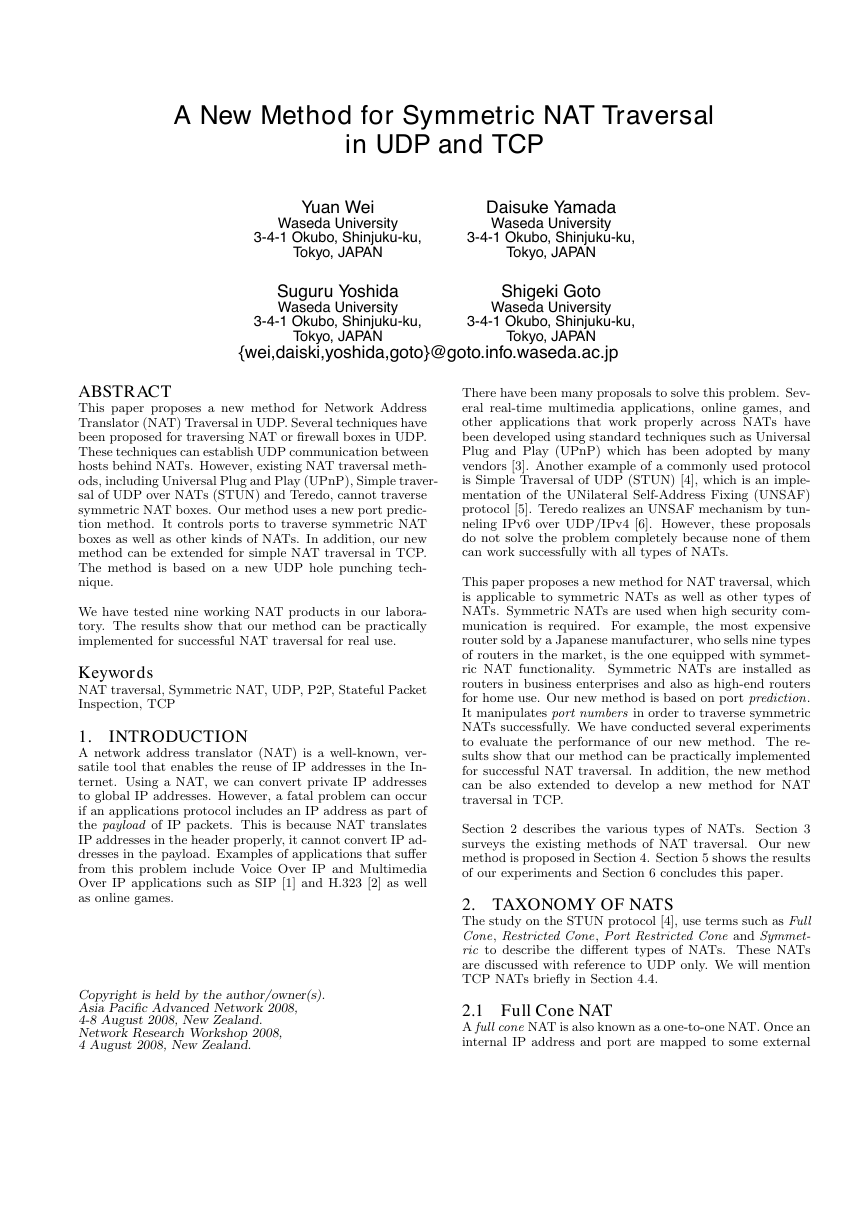
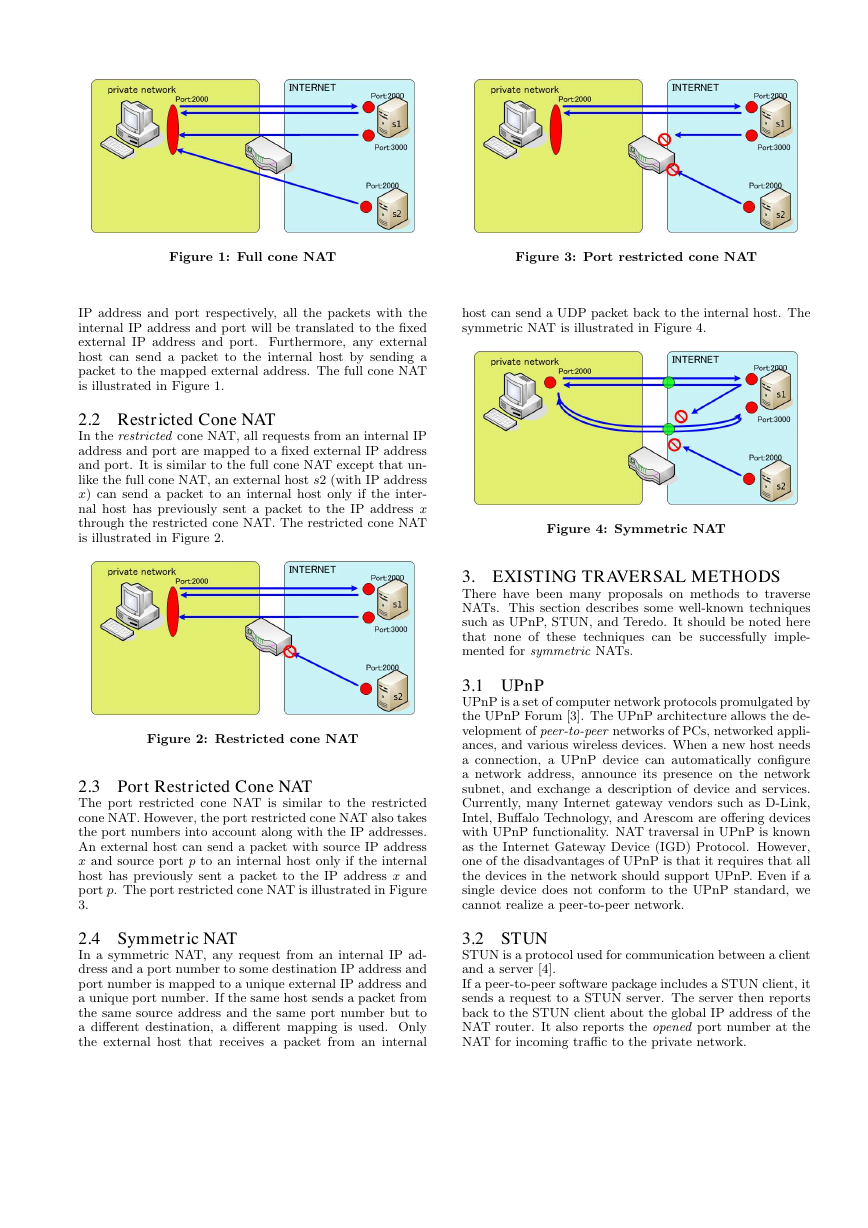

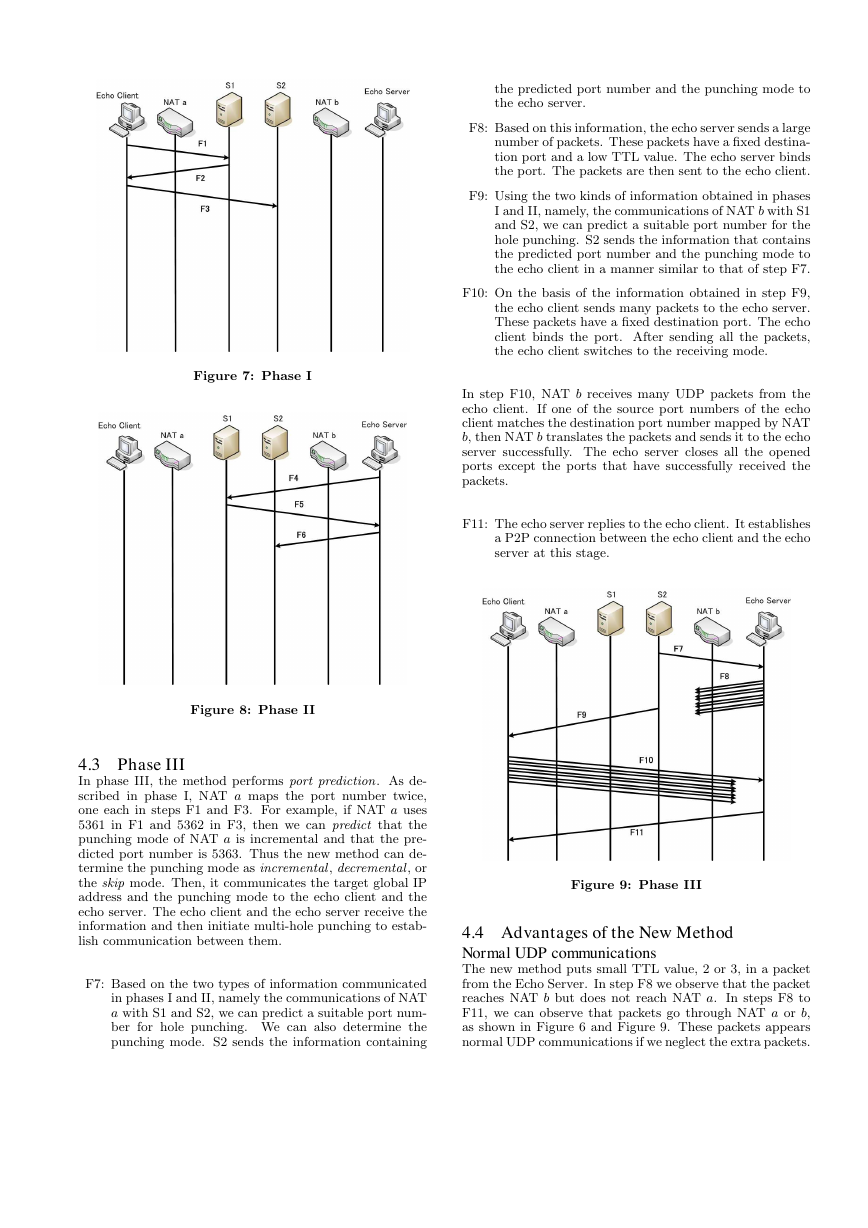


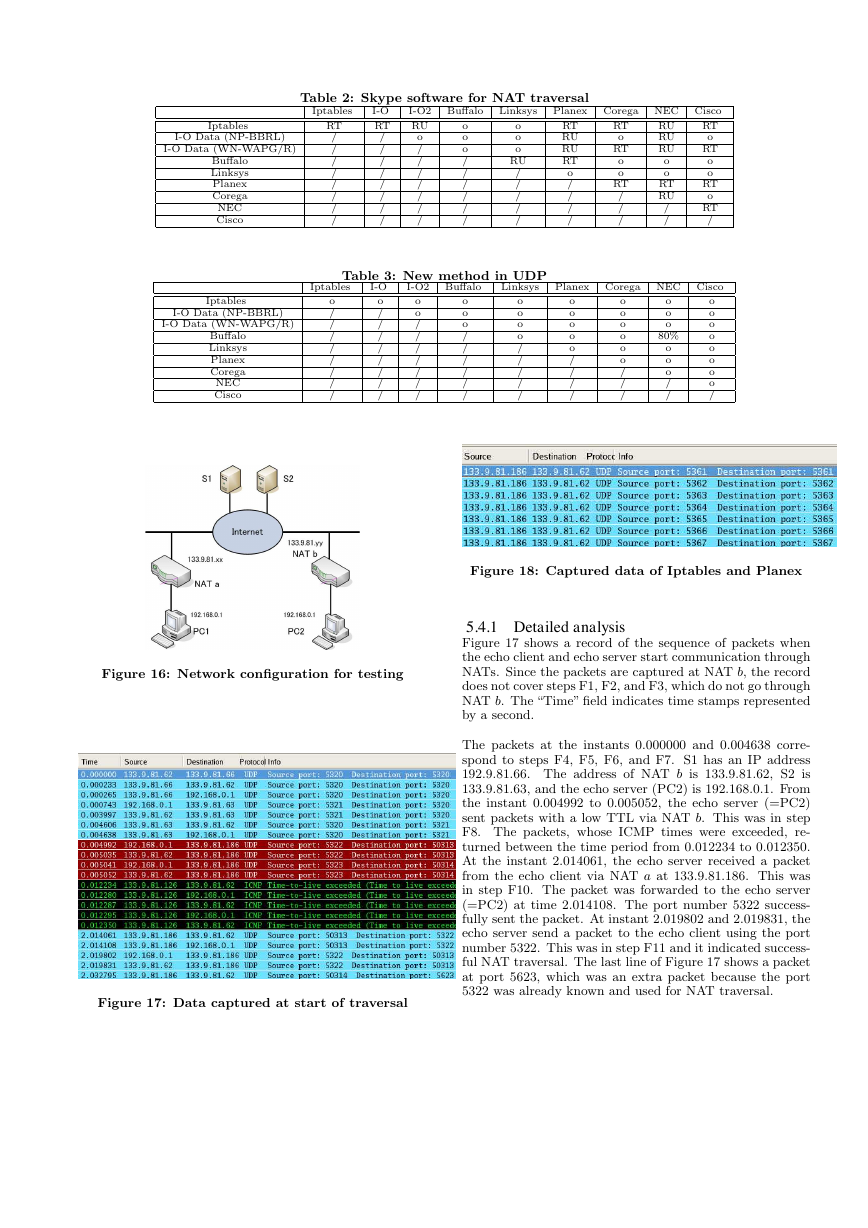
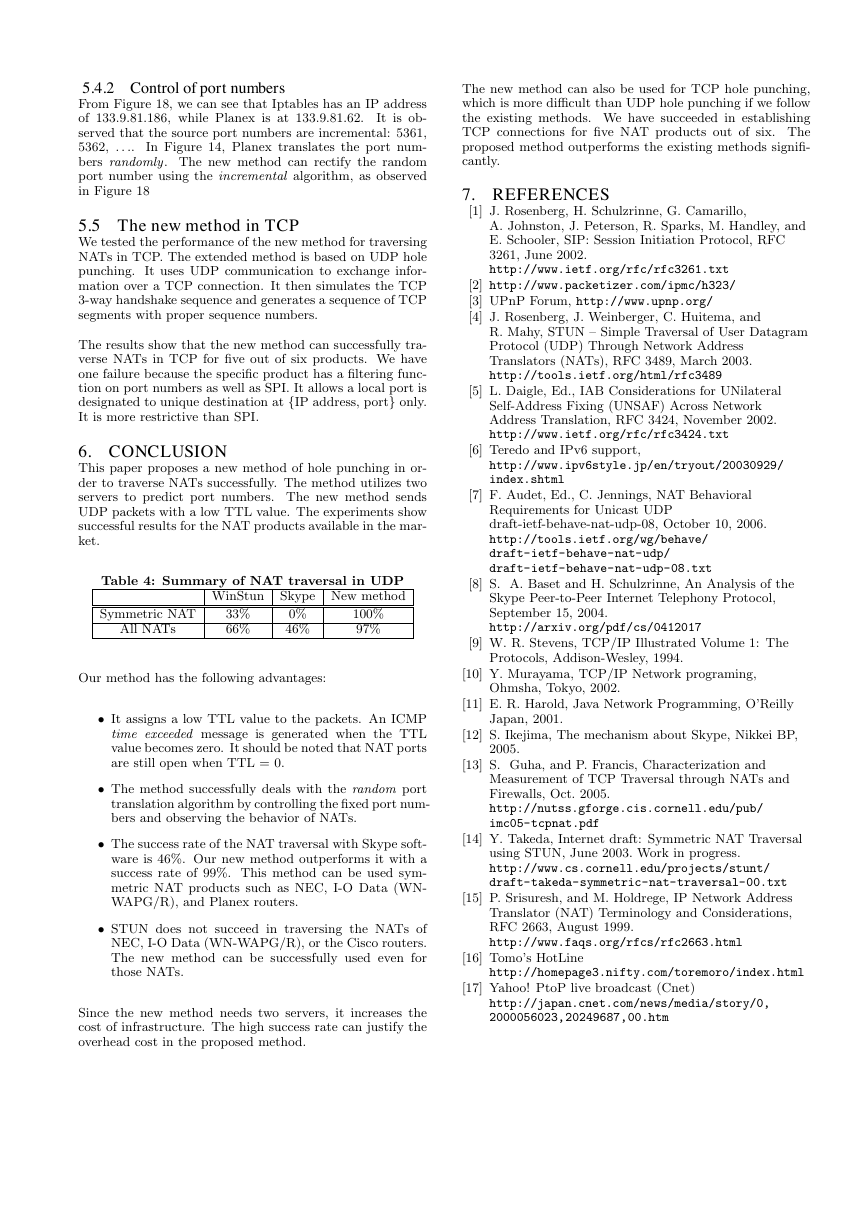








 2023年江西萍乡中考道德与法治真题及答案.doc
2023年江西萍乡中考道德与法治真题及答案.doc 2012年重庆南川中考生物真题及答案.doc
2012年重庆南川中考生物真题及答案.doc 2013年江西师范大学地理学综合及文艺理论基础考研真题.doc
2013年江西师范大学地理学综合及文艺理论基础考研真题.doc 2020年四川甘孜小升初语文真题及答案I卷.doc
2020年四川甘孜小升初语文真题及答案I卷.doc 2020年注册岩土工程师专业基础考试真题及答案.doc
2020年注册岩土工程师专业基础考试真题及答案.doc 2023-2024学年福建省厦门市九年级上学期数学月考试题及答案.doc
2023-2024学年福建省厦门市九年级上学期数学月考试题及答案.doc 2021-2022学年辽宁省沈阳市大东区九年级上学期语文期末试题及答案.doc
2021-2022学年辽宁省沈阳市大东区九年级上学期语文期末试题及答案.doc 2022-2023学年北京东城区初三第一学期物理期末试卷及答案.doc
2022-2023学年北京东城区初三第一学期物理期末试卷及答案.doc 2018上半年江西教师资格初中地理学科知识与教学能力真题及答案.doc
2018上半年江西教师资格初中地理学科知识与教学能力真题及答案.doc 2012年河北国家公务员申论考试真题及答案-省级.doc
2012年河北国家公务员申论考试真题及答案-省级.doc 2020-2021学年江苏省扬州市江都区邵樊片九年级上学期数学第一次质量检测试题及答案.doc
2020-2021学年江苏省扬州市江都区邵樊片九年级上学期数学第一次质量检测试题及答案.doc 2022下半年黑龙江教师资格证中学综合素质真题及答案.doc
2022下半年黑龙江教师资格证中学综合素质真题及答案.doc